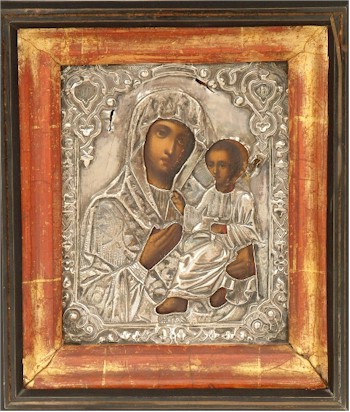
A late 18th century Russian silver casket of melon form, raised on floral decorated feet, made in St Petersburg in 1785.
Most items of Russian silver that come through our Silver department date from the late 18th century up until the Communist Revolution in 1917. The majority of the pieces are normally late 19th and early 20th century.
Prior to the revolution, the vast majority of Russians were living in serfdom. Despite this, Russia was not a backward country. It was well integrated with the rest of continental Europe, Asia and the Far East. This brought to the silversmiths a wealth of objects, designs and techniques for inspiration for their craft.
Moscow and St Petersburg attracted artists and artisans from France, Germany and many of the Scandinavian countries, especially Finland. Not only that, but Russian silver was exhibited at all the great exhibitions held in the European capitals as well as in America. It is not until the Communist Revolution in 1917 that the heyday of Russian silver came to an abrupt end.
Russian silver itself, generally speaking, is not as pure as English silver. Sterling silver is 925 parts per 1000, whereas Russian silver is only 875 parts per 1000, items to this standard are hallmarked with the number 84. Items that met the English standard and were probably meant for export to this country are stamped with the number 91. Other marks will include the town of origin, the assay master's mark who tested the piece for purity and the maker's mark. Prior to 1899, the assay master would also include the date he tested the piece.

A 19th century Russian silver and niello decorated snuff box, decorated in a simpler geometric pattern.
Designs in Russian silver broadly reflected the decorative tastes of the rest of Europe, from Gothic through to the naturalistic style of articles decorated with flowerheads and foliage. Some items remained in a more traditional style and such items included a shoe shaped drinking vessel called a Kovsh and, of course, eggs which could be either highly decorated with enamels or just plain silver. These were given by wealthier families at Easter, which is a major celebration in the Russian Orthodox Church.

Another example of a niello decorated snuff box this time with the lid decorated with a view of Moscow dating from 1847.
Keeping away from Faberge and highly ornamental enamel objects, a simpler and more common form of enamelling is Niello work. Niello designs can range from simple geometric patterns to views of major Russian cities such as St Petersburg or Moscow). Another typically traditional design is scenes depicting Russian sleighs, known as troikas. These Niello decorated boxes are probably the most common items to pass through the auction rooms. Their quality can vary from fairly plain and boring to little masterpieces of the enameller's art.

A late 19th century Russian Icon of The Madonna and Child the image contained within a silver oklad.
Another area that shows off the silversmith's art is in the decoration of icons. Icons were images of Christ, the Virgin Mary or Saints and were kept in most houses to ward off the evil works of the devil. They were normally oil paintings on wooden boards and sometimes had a silver frame that enclosed the painted image. Such frames are called an oklad and are often engraved with either sunburst or a dove representing the Holy Spirit. The oklad would be fully hallmarked and there were certain companies who specialised in icon decoration.

A pair of late 18th century Russian silver gilt and niello decorated vodka beakers (charka) dating from 1789.
Other items that have passed through our salerooms in the past four years include a pair of silver and gilt decorated Vodka tumblers or Charka, which dated from the late 18th century. Charka can vary from small (20ml) to large (120ml). The use of gilding accentuating the decoration. These particular Russian silver Charka realised £3,700 at auction.

A Russian silver cigarette case of naturalistic form, with gold and gem set clasp dates from the early 1900s.
Another popular item of Russian silver that appears regularly are cigarette cases and the example shown above is a naturalistic design of plain and simple form using gold to complement the silver and inset with a gemstone. Most of these cases date from the Art Nouveau period but are far more restrained than their continental counterparts. The Art Nouveau movement, whilst strong in central and Western Europe, had no great influence on the Russian silversmiths.
The reasons that Russian silver has become so popular over the past eight years are complex. Greater knowledge of the silversmiths and silver retailers has become more easily obtainable. Up until the fall of the Communist regime in Russia and Eastern Europe, few items of silver were available on the English market, but there has been a rise in the number of wealthy Russian collectors who are willing to repatriate Russian silver back to the Motherland. Dogged by political turmoil, civil war and world war, Russian silver is once again taking up an important place in world markets.
- Bearnes Hampton & Littlewood
- Fine Silver
- Russian Silver
- Troikas
- Charka
- Oklad
- Russian Orthodox Icons
- Cigarette Cases
- Snuff Boxes
Russian Silver was written on Friday, 10th May 2013.









